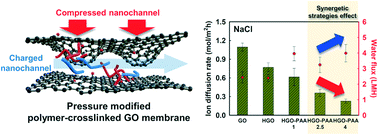Synergetic effect of physicochemical and electrostatic strategies on ion sieving for polymer cross-linked graphene oxide membranes†
Abstract
Layered-stacked graphene oxide (GO) membranes have shown ultrafast water permeability and ion selectivity by virtue of their well-defined nanochannels and intrinsic surface charge properties; however, the accumulation of water molecules in GO capillaries makes it difficult to sieve monovalent ions, despite having narrow channels in the dry state. Here, pressure-controlled nanochannels in polymer-crosslinked GO membranes are designed for improving ion blocking performance as well as achieving high water permeability. The layer-connected architecture is created by amide bonds formed between hyper-branched polyethylenimine (HPEI) and polyacrylic acid (PAA). As the layer-stacked channel of this obtained HPEI-GO (HGO) membrane is susceptible to the applied pressure that can forcibly reduce the broadened interlayer distance, it is possible to create rigid cross-linked structures with a controllable channel size. Therefore, the highly compressed nanochannel with zwitterionic charged properties effectively suppresses the permeation of ions with a NaCl permeation rate of 0.2268 ± 0.033 mol m−2 h−1, which corresponds to 4.8-fold improvement over the pristine GO membrane. In addition, as the inserted PAA morphology changes depending on the pressure, the linear shape of PAA inside the narrowest channel exposes more functional groups which can participate in hydrogen bonding, leading to the increased water flux contrary to the trade-off relationship. Self-diffusion coefficients of water and ions and binding energy calculated by molecular simulations provide further insights into their behaviour in the nanochannels. It is anticipated that this strategy which combines physicochemical and electrostatic modifications can be exploited for tuning nanochannels of 2D-based membranes to achieve simultaneously fast water permeability and ion rejection.

- This article is part of the themed collection: Nanomaterial applications in water


 Please wait while we load your content...
Please wait while we load your content...